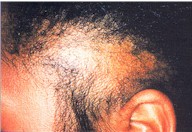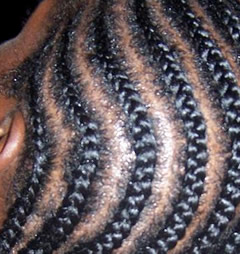Traction Alopecia Dallas
Traction Alopecia Explained
There are three major types of mechanically induced hair loss: Trauma, Traction and/or Pressure.

Traumatic Alopecia
The most common type of cicatricial alopecia develops from traumatic injury. Pressure injuries arise if a patient is unconscious and lies completely immobile for an extended period of time. The body weight causes loss of blood supply to the overlying skin, which in turn causes necrosis and subsequent hair loss.

Traction Alopecia Causes
Traction alopecia may over the short run cause temporary hair loss but over time with continued traction the follicles may atrophy leading to permanent hair loss. Tight ponytails and braiding can cause short broken hairs, follicular inflammation, and patchy hair loss. Africans, in particular, wear hairstyles with tight braiding that can lead to traction alopecia. Hair weaving to maintain a wig or hair system can also lead to further loss in the woven hairs.
Frontal and Parietal Traction Alopecia
 Frontal and parietal traction alopecia can arise in young Sikh boys who twist their uncut hair on the top of their head under a turban. Sudanese women and young Zande males develop frontal hairline traction alopecia from hardwood combs thrust horizontally back on the scalps.Many patients fail to recognize that traction alopecia is the cause of their hair loss and may have trouble accepting the physician’s diagnosis. The first order of business is to educate the patient about alternative hairstyling practices to eliminate the sustained traction on the susceptible hairs. If hair does not return, surgical hair restoration is the only option to correct the problem.
Frontal and parietal traction alopecia can arise in young Sikh boys who twist their uncut hair on the top of their head under a turban. Sudanese women and young Zande males develop frontal hairline traction alopecia from hardwood combs thrust horizontally back on the scalps.Many patients fail to recognize that traction alopecia is the cause of their hair loss and may have trouble accepting the physician’s diagnosis. The first order of business is to educate the patient about alternative hairstyling practices to eliminate the sustained traction on the susceptible hairs. If hair does not return, surgical hair restoration is the only option to correct the problem.




